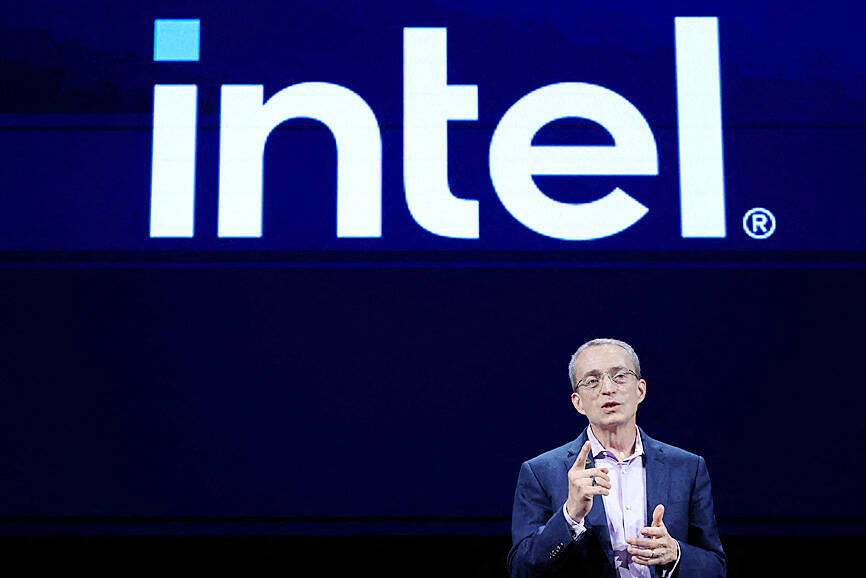Intel on Thursday said it would cut more than 15 percent of its workforce and suspend its dividend starting in the fourth quarter, as the chipmaker pursues a turnaround centered around its loss-making manufacturing business.
It also forecast third-quarter revenue below estimates, grappling with a pullback in spending on traditional data center semiconductors and a focus on artificial intelligence (AI) chips, where it lags rivals.
Intel shares fell 20 percent in extended trade, setting it up to lose more than US$24 billion in market value. The stock had closed down 7 percent on Thursday, in tandem with a plunge in US chip stocks after a conservative forecast from Arm Holdings PLC on Wednesday.

Photo: Ann Wang, Reuters
The results did not rock the broader chip industry. AI powerhouse Nvidia Corp and smaller rival Advanced Micro Devices Inc ticked up after hours, underscoring how well-positioned they were to take advantage of the AI boom.
“I need less people at headquarters, more people in the field, supporting customers,” Intel CEO Pat Gelsinger told Reuters in an interview. On the dividend suspension, he said: “Our objective is to ... pay a competitive dividend over time, but right now, focusing on the balance sheet, deleveraging.”
The layoffs would impact roughly 17,500 people.
Intel, which employed 116,500 people as of June 29, excluding some subsidiaries, said the majority of the job cuts would be completed by the end of the year.
The company also announced it would cut operating expenses and reduce capital expenditure by more than US$10 billion next year, more than it initially planned.
“A US$10 billion cost reduction plan shows that management is willing to take strong and drastic measures to right the ship and fix problems. But we are all asking, ‘is it enough’ and is it a bit of a late reaction considering that CEO Gelsinger has been at the helm for over three years?” Running Point Capital chief investment officer Michael Schulman said.
Scraping dividend might further pressure the shares in the short to medium-term, because it would knock Intel out of any exchange-traded funds, indices and fund strategies that only include dividend payers, Schulman said.
The company had cash and cash equivalents of US$11.29 billion, and total current liabilities of about US$32 billion as of June 29.
Much of Wall Street’s focus has centered around the heavy investments and huge costs incurred by Intel as it builds out its manufacturing capacity in a bid to compete against Taiwan Semiconductor Manufacturing Co (TSMC, 台積電).
Intel’s lagging position in the market for AI chips has sent its shares down more than 40 percent so far this year.
As part of its cost reduction, Intel expects to slash capital expenses by 17 percent next year year-on-year to US$21.5 billion, calculated on the midpoint of a range the chipmaker forecast. It expects these costs to stay roughly flat this year.
“On one hand, Intel is witnessing the erosion of its traditional data center business as chip buyers aggressively migrate towards AI chips. On the other hand, Intel is navigating a challenging and expensive transformation to a foundry model,” Global X research analyst Tejas Dessai said.
Intel adopted extreme ultraviolet (EUV) lithography tools much later than TSMC did, which caused the US chipmaker’s foundry business to lag the Taiwanese manufacturer. The company is working to rectify that. It became the first to assemble one of Dutch chip gear maker ASML Holding NV’s new high-NA EUV lithography tools in April.
Analysts believe Intel’s plan to turn around the foundry business would take years to materialize and expect TSMC to maintain its lead in the coming years.

RECYCLE: Taiwan would aid manufacturers in refining rare earths from discarded appliances, which would fit the nation’s circular economy goals, minister Kung said Taiwan would work with the US and Japan on a proposed cooperation initiative in response to Beijing’s newly announced rare earth export curbs, Minister of Economic Affairs Kung Ming-hsin (龔明鑫) said yesterday. China last week announced new restrictions requiring companies to obtain export licenses if their products contain more than 0.1 percent of Chinese-origin rare earths by value. US Secretary of the Treasury Scott Bessent on Wednesday responded by saying that Beijing was “unreliable” in its rare earths exports, adding that the US would “neither be commanded, nor controlled” by China, several media outlets reported. Japanese Minister of Finance Katsunobu Kato yesterday also

China Airlines Ltd (CAL, 中華航空) said it expects peak season effects in the fourth quarter to continue to boost demand for passenger flights and cargo services, after reporting its second-highest-ever September sales on Monday. The carrier said it posted NT$15.88 billion (US$517 million) in consolidated sales last month, trailing only September last year’s NT$16.01 billion. Last month, CAL generated NT$8.77 billion from its passenger flights and NT$5.37 billion from cargo services, it said. In the first nine months of this year, the carrier posted NT$154.93 billion in cumulative sales, up 2.62 percent from a year earlier, marking the second-highest level for the January-September

‘DRAMATIC AND POSITIVE’: AI growth would be better than it previously forecast and would stay robust even if the Chinese market became inaccessible for customers, it said Taiwan Semiconductor Manufacturing Co (TSMC, 台積電) yesterday raised its full-year revenue growth outlook after posting record profit for last quarter, despite growing market concern about an artificial intelligence (AI) bubble. The company said it expects revenue to expand about 35 percent year-on-year, driven mainly by faster-than-expected demand for leading-edge chips for AI applications. The world’s biggest contract chipmaker in July projected that revenue this year would expand about 30 percent in US dollar terms. The company also slightly hiked its capital expenditure for this year to US$40 billion to US$42 billion, compared with US$38 billion to US$42 billion it set previously. “AI demand actually

Jensen Huang (黃仁勳), founder and CEO of US-based artificial intelligence chip designer Nvidia Corp and Taiwan Semiconductor Manufacturing Co (TSMC, 台積電) on Friday celebrated the first Nvidia Blackwell wafer produced on US soil. Huang visited TSMC’s advanced wafer fab in the US state of Arizona and joined the Taiwanese chipmaker’s executives to witness the efforts to “build the infrastructure that powers the world’s AI factories, right here in America,” Nvidia said in a statement. At the event, Huang joined Y.L. Wang (王英郎), vice president of operations at TSMC, in signing their names on the Blackwell wafer to